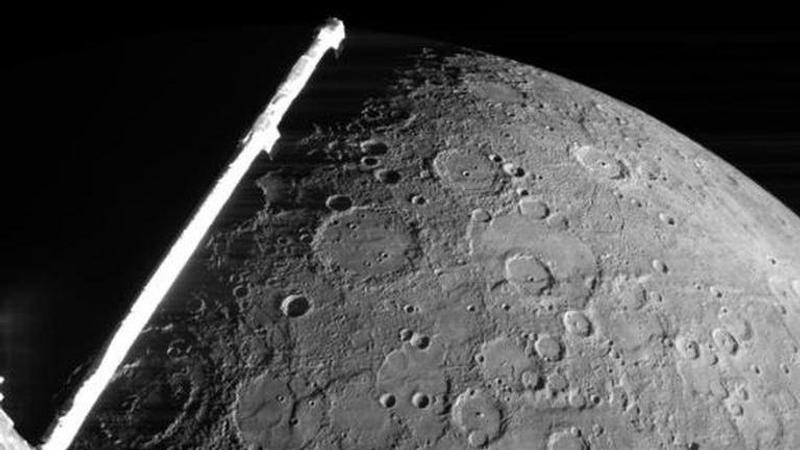Published 22:50 IST, June 23rd 2022
BepiColombo makes second closest approach to Mercury; ESA shares fascinating picture
BepiColombo, launched in October 2018, made its second closest approach to Mercury on June 23 from an altitude of just 200 kilometres.

The BepiColombo spacecraft made its second closest approach to Mercury on June 23. Launched on October 20, 2018, the spacecraft skimmed over Mercury's surface at 3:14 p.m. (IST) and was just 200 kilometres above the planet's surface. Earlier today, the European Space Agency (ESA) shared a picture captured by the Mercury Transfer Module’s Monitoring Camera 2 from a distance of 920 kilometres, five minutes after the closest approach.
What did BepiColombo see?
In the image captured by the spacecraft, ESA marked out Mercury's landscape and the impact craters. One important feature visible in this picture is the straight sunlit scarp named 'Challenger Rupes' at the bottom of the image. Measuring 200 kilometres long, about 170 kilometres of the two-kilometres tall feature has been photographed. Interestingly, it got its name as early as earlier this month from the International Astronomical Union Working Group for Planetary System Nomenclature.
Moreover, crater such as the Izquierdo and smooth plains named Catuilla Planum and Kunisada are also some of Mercury's prominent features which are highlighted in the unique lighting. ESA says that the lighting conditions in this image are different from any recorded instance. According to the agency, the 130 km-wide Eminescu crater, towards the top right of the image, will be an interesting subject of study for BepiColombo as it contains ‘hollows’, geological features unique to Mercury.
Besides, the 24 km-wide Xiao Zhao has also caught the eye of scientists owing to the bright streaks radiating from it. "These ‘rays’ are formed from material ejected during the impact event that carved out the crater, and fade away within a few hundreds of millions of years", ESA said in a statement. "This tells us that Xiao Zhao is one of the more recent impact craters on Mercury". Notably, BepiColombo will perform a total of six flybys before it enters Mercury's orbit in December 2025.
More about BepiColombo
Jointly developed by ESA and the Japan Aerospace Exploration Agency (JAXA), the BepiColombo mission includes two spacecraft - ESA's Mercury Planetary Orbiter (MPO) and Japan's Mercury Magnetospheric Orbiter (MIO), both of which are fitted onto the Mercury Transfer Module (MTM). Through this mission, scientists of ESA and the Japan Aerospace Exploration Agency (JAXA) aim to conduct comprehensive observations of Mercury’s magnetic field, the magnetosphere, and both its surface and interior.
Once the probes reach Mercury, they will separate from the MTM and will be inserted into different orbits. The MPO will observe Mercury's surface and interior in a 2.3-hour orbit whereas the MIO will study the magnetic fields in a 9.3-hour orbit.
Updated 22:50 IST, June 23rd 2022



